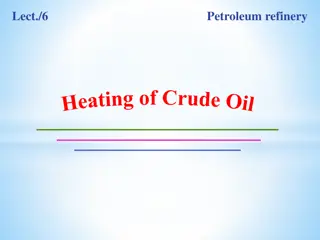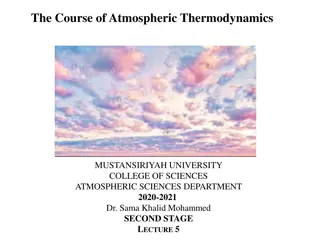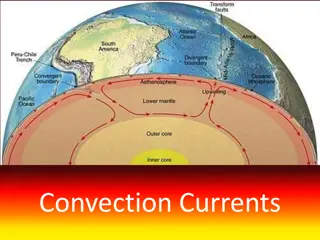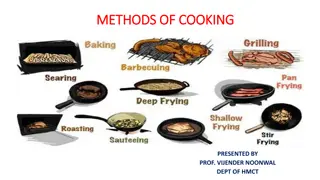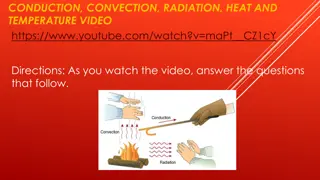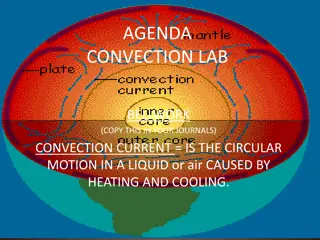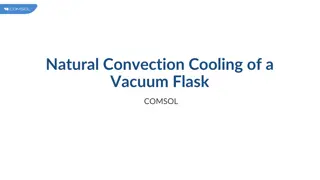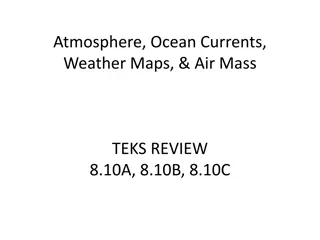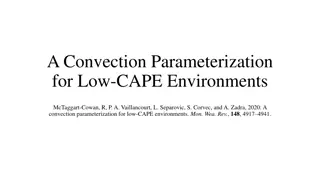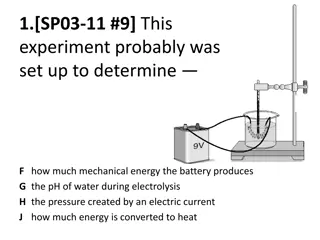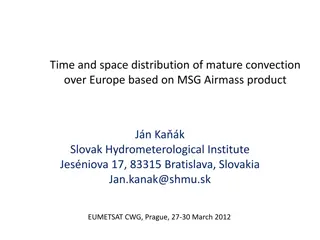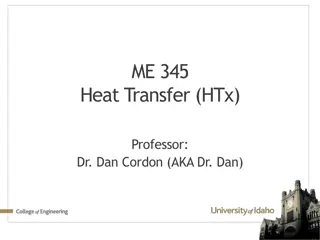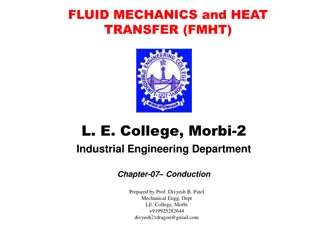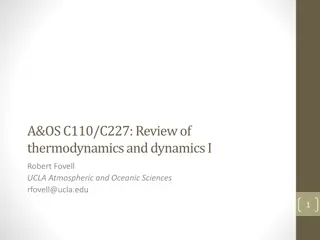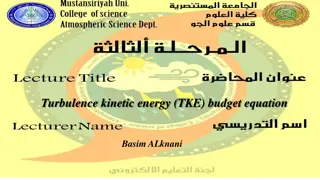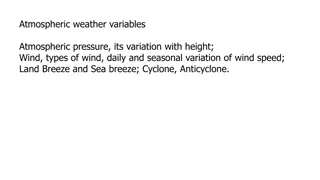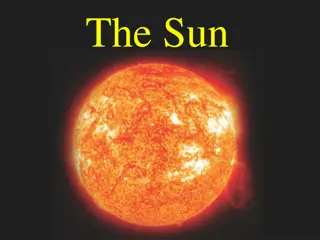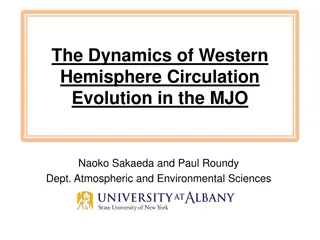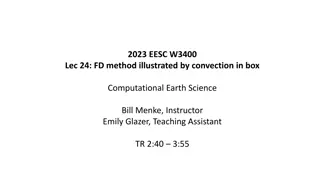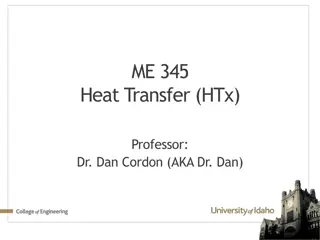Heating of Crude Oil
The process of heating crude oil in petroleum refineries involves various types of furnaces and heat distribution methods. The furnaces can be categorized into box, cylindrical, and radiant wall types, each with separate radiation and convection sections. Design considerations include heat transfer
4 views • 24 slides
Atmospheric Thermodynamics in Second Stage Lecture
Explore key concepts in atmospheric thermodynamics, including condensation level, free convection level, and the use of thermodynamic diagrams. Learn about the process of condensation, stability levels in the atmosphere, and the significance of free convection in weather patterns. Discover why therm
0 views • 27 slides
Convection Currents in Earth's Systems
Convection currents refer to the movement of heat by fluids like liquids and gases, transferring heat from one place to another. They play a significant role in the geosphere, atmosphere, and hydrosphere of the Earth, influencing phenomena such as plate tectonics, winds, and ocean currents. In the g
2 views • 12 slides
Cooking Methods: Conduction and Convection Explained
Cooking methods like conduction and convection are fundamental in culinary arts. Conduction involves direct heat transfer through matter, while convection utilizes the movement of fluids for heat transfer. Gravity and buoyancy play crucial roles in natural convection processes, resulting in efficien
7 views • 45 slides
Heat Energy Transfer and Principles
Heat energy is the result of particle movement in solids, liquids, and gases. It can be transferred through conduction, convection, and radiation. Conduction occurs through direct contact, convection involves the movement of fluids, and radiation transfers heat through empty space. Understanding how
3 views • 14 slides
Heat Transfer: Conduction, Convection, Radiation
Explore the concepts of conduction, convection, and radiation in heat transfer through an engaging video. Learn how thermal energy is transferred through solids, liquids, and gases, and understand the role of insulation in preventing heat transfer. Discover why hot water rises and cold water sinks,
2 views • 5 slides
Atmospheric Pressure Variations at Different Altitudes
Atmospheric pressure varies with altitude due to the weight of the air column above. This activity explores how Otto von Guericke's experiments with vacuum systems demonstrate the power of air pressure. Theoretical concepts of atmospheric pressure are discussed, highlighting its relation to gravity
3 views • 28 slides
Heat Transfer in Science
Investigate and understand the movement of heat between objects through conduction, convection, and radiation. Learn to compare materials that conduct heat with insulating materials, describe heat transfer processes, and design experiments to study heat energy movement. Explore the use of ratio reas
5 views • 31 slides
Convection Currents Lab Activity
Engage students in a hands-on lab activity to observe convection currents in action. The agenda includes bell work about convection, a hypothesis on confetti paper movement in hot water, detailed lab procedures, drawing conclusions with CER format, and thought-provoking conclusion questions related
4 views • 7 slides
Cutting-Edge Atmospheric Chemistry Modeling Research at Barcelona Supercomputing Center
Conducted by the Atmospheric Composition Group at Barcelona Supercomputing Center, this cutting-edge research focuses on atmospheric chemistry modeling using advanced tools and frameworks like HERMESv3 and MONARCH. The team's approach integrates various modules to study complex processes influencing
0 views • 16 slides
Modeling Natural Convection Cooling of a Vacuum Flask in COMSOL
This example demonstrates the modeling of natural convection cooling in a vacuum flask holding hot coffee using COMSOL. It compares two approaches to describe thermal dissipation, focusing on calculating the flask's cooling power over time. Results include temperature analysis, heat transfer coeffic
4 views • 11 slides
Atmosphere, Ocean Currents, Weather Maps, & Air Mass TEKS Review
Explore key concepts related to atmosphere, ocean currents, weather maps, and air mass in this TEKS review. Understand the factors contributing to Earth's uneven heating, the role of convection in ocean currents, the energy sources that drive ocean convection, and the effects of heating on air densi
0 views • 21 slides
Convection Parameterization for Low-CAPE Environments
Many global Numerical Weather Prediction systems face challenges predicting convective activity in low-CAPE environments. This study introduces a convection parameterization scheme based on moisture convergence to better represent convective effects. The scheme focuses on the triggering function, up
5 views • 38 slides
Heat Transfer in Scientific Experiments
Explore various scientific experiments related to heat transfer, including determining energy produced by batteries, heat convection in gases and liquids, detecting warmth through a door, energy transformations in the Earth system, and optimizing solar heaters. Learn about conduction, convection, ra
0 views • 16 slides
Mature Convection Distribution Over Europe
Analyzing the time and space distribution of mature convection over Europe based on MSG Airmass product from Slovak Hydrometeorological Institute. The data covers various timeframes and processing steps, highlighting the dependence on Sun elevation, daytime hours, and monthly variations. Statistical
1 views • 11 slides
Heat Transfer in Convection: Key Parameters and Correlations
Explore the fundamentals of heat transfer in convection, focusing on external flow, important dimensionless parameters like Nusselt and Sherwood numbers, empirical correlations, film temperature concept, and local laminar flat plate correlations. Learn about key concepts and equations used in analyz
2 views • 26 slides
Heat Transfer: Conduction, Convection, and Radiation
Heat transfer is a fundamental process that occurs through conduction, convection, and radiation. Conduction involves the transfer of heat between particles through direct contact, while convection moves heat within fluids and gases through currents. Radiation is heat transfer through electromagneti
5 views • 13 slides
Atmospheric Composition and Structure
The presentation covers fundamental concepts related to the Earth's atmosphere, including its composition, origin of oxygen, dry and moist layers, standard atmosphere layers, and temperature variations. Key topics discussed include the primordial atmosphere, atmospheric constituents, water vapor dis
1 views • 58 slides
Turbulence Kinetic Energy (TKE) Budget Equations Overview
The Turbulence Kinetic Energy (TKE) budget equation explores the different terms contributing to the generation and consumption of turbulence in the atmosphere. It delves into the effects of buoyant production/consumption, mechanical (shear) production, and the importance of Term III in free convect
4 views • 12 slides
Atmospheric Pressure, Wind Variations, and Humidity in Weather Systems
The atmosphere is composed of various elements like gaseous molecules, water vapor, and dust particles. Key weather variables include atmospheric pressure, temperature, humidity, wind, cloud cover, and precipitation. Atmospheric pressure is influenced by the weight of air above a point, with average
5 views • 17 slides
Heat Transfer Methods and Insulation
Explore the various methods of heat transfer such as conduction, convection, and radiation, along with the roles of conductors and insulators in managing heat. Discover why metals feel cool to the touch, how insulated containers work, and the mechanism behind a Thermos. Delve into the concepts of co
2 views • 14 slides
Exploring the Structure and Phenomena of the Sun
Discover the intricate balance and core structure of the Sun, maintained by hydrostatic equilibrium. Energy moves through radiation and convection zones, with convection manifesting as granulation on the photosphere. Eclipses, such as solar eclipses, provide unique opportunities to witness celestial
2 views • 12 slides
Extended Surface Heat Transfer in Thermal Fluids Laboratory
This laboratory explores heat transfer in a single cylindrical extended surface (a fin) under free and forced convection to understand fin effectiveness and influencing parameters. Various types of fins like rectangular, triangular, annular, and pin fins are discussed, along with primary modes of he
0 views • 19 slides
Heat Transfer: A Comprehensive Overview
Heat transfer is a fundamental concept in physics, where energy moves from hot to cold objects through conduction, radiation, and convection. Heat is not a substance but a form of energy that speeds up molecules. Conduction transfers heat between substances in direct contact, while convection involv
11 views • 13 slides
Evolution of Western Hemisphere Circulation in MJO
In this study by Naoko Sakaeda and Paul Roundy from the Dept. of Atmospheric and Environmental Sciences, the dynamics of Western Hemisphere circulation evolution in the Madden-Julian Oscillation (MJO) are explored. The research focuses on analyzing composite MJO events, utilizing the Western Hemisph
1 views • 21 slides
Future Changes in Atmospheric Rivers in Norway
Research investigates future trends in atmospheric rivers and extreme precipitation in Norway. Findings show increasing frequency and intensity of atmospheric rivers in the Far-Future, particularly during summer, with winter precipitation rising on the mid- and south-west coasts. Utilizing data obse
2 views • 13 slides
Introduction to Conservation of Momentum in Fluid Dynamics
Explore the fundamentals of the Navier-Stokes Equation, incompressibility condition, heat flow equation, dynamics of convection, and the Boussinesq Approximation. Learn about the setup for convection in a box and the finite difference simulation of convection, along with terms like vector notation a
0 views • 67 slides
Forced Convection – Internal Flow
This document delves into the principles of forced convection internal flow in mechanical engineering, covering hydrodynamic and thermal considerations, empirical correlations, and practical applications. It explores the unique features of boundary layer development, energy balances, and convection
2 views • 29 slides
Atmospheric Sciences 101 Atmospheric Sciences 101
Dive into the fascinating world of atmospheric sciences with this comprehensive course. Learn to interpret weather maps, satellite imagery, and radar data. Explore key atmospheric phenomena and their relation to physical principles and laws. Discover how to be a savvy weather consumer by understandi
0 views • 10 slides
Heat Transfer and Energy Sources
Explore the mechanisms of heat transfer through Earth's system, including radiation, conduction, and convection. Learn how density variations cause movement in the atmosphere, water, and rocks, and understand the role of solar radiation in heating Earth. Discover how energy is transferred by radiati
2 views • 10 slides
Atmospheric Sciences Course: Winter 2023
Gain an understanding of synoptic systems, dynamical concepts, and weather forecasting in the Atmospheric Sciences 370 course for Winter 2023 with Cliff Mass and Rick Steed. Explore the structure and evolution of weather phenomena, developing essential skills in atmospheric analysis and forecasting
0 views • 6 slides
Convection: Understanding Heat Transfer over Different 2D Shapes
Explore the convection phenomena over various 2D shapes in cross flow, such as an infinitely long cylinder, and learn how momentum affects flow transition from laminar to turbulent. Discover the significance of Reynolds Number, drag coefficient calculations, and the average Nusselt Number equation f
4 views • 18 slides
Weather Convection Schemes and Observation Basis
Understand the various convection schemes used in weather forecasting, such as Manabe et al. (1965) and Arakawa and Schubert (1974). Explore concepts like critical relative humidity and moisture supply methods. Learn about observational bases for cumulus clouds and the initiation of convective proce
0 views • 34 slides
Lunar Atmospheric Composition Experiment: Insights into Moon's Atmosphere
The Lunar Atmospheric Composition Experiment (LACE) on Apollo 17 provided valuable data on the Moon's exosphere, gas molecules, and atmospheric dynamics. LACE's ionization process, mass range scans, and data records offer a deeper understanding of lunar atmospheric composition. Discover the impacts
1 views • 11 slides
Unveiling Convection Currents in Earth's Mantle
Dive into the intriguing world of convection currents, explore how they work, and understand their significance in the Earth's mantle dynamics. Witness the flow of hot and cold substances, discover why hot water rises, and unravel the mysteries of these natural phenomena. Explore the application of
4 views • 7 slides
Heat Transfer and Convection in Engineering
Explore the fundamentals of heat transfer and convection in engineering, covering topics such as boundary layer analysis, convection coefficients, and Newton's Law of Cooling. Gain insights into classifying different types of flows and the importance of local vs. average convection coefficients. Dis
3 views • 12 slides
Atmospheric Thermodynamics Fundamentals
This lecture covers key concepts in atmospheric thermodynamics, including forms of energy, Earth's atmosphere overview, composition, vertical structure, pressure, temperature, density, and important equations like the hydrostatic and hypsometric equations. Gain insights into the fundamentals of atmo
2 views • 21 slides
Understanding Atmospheric Thermodynamics: Dry Air, Stability, Buoyancy
Explore the concepts of dry air, stability, and buoyancy in atmospheric thermodynamics through this detailed lecture. Learn about the definitions of dry air, stability of dry air with adiabatic lapse rate, and the role of buoyancy in atmospheric conditions. Dive into the dynamics of potential temper
2 views • 15 slides
Understanding Atmospheric Temperature and Heat Transfer Mechanisms
Discover the relationship between atmospheric temperature and heat transfer, highlighting the impact of solar radiation, conduction, convection, and radiation in heating and cooling the atmosphere. Learn the distinctions between heat and temperature and how they play crucial roles in Earth's climate
2 views • 4 slides
Numerical Simulations of Convections and Rayleigh-Bénard Convection Study
Explore the research on numerical simulations of convections conducted by Eleisha Jackson at the University of Arizona, focusing on solving differential equations using MATLAB and the Pseudo-Spectral Collocation Method. The study delves into fluid flow phenomena, specifically Rayleigh-Bénard Convec
0 views • 13 slides
